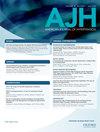A Single Bout of Prolonged Sitting Augments Very Short-Term Blood Pressure Variability
IF 3.1
3区 医学
Q2 PERIPHERAL VASCULAR DISEASE
引用次数: 0
Abstract
Background More habitual time spent engaging in prolonged sedentary behaviours increases the risk of developing hypertension. Beat-by-beat systolic (SBPV) and diastolic blood pressure variability (DBPV) are more pronounced in persons with hypertension and may be an early manifestation of blood pressure dysregulation. We tested the hypothesis that a single bout of prolonged sitting augments very short-term SBPV and DBPV. The secondary aim was to explore sex differences in prolonged sitting-induced increases in SBPV and DBPV. Methods Thirty-three adults (22.9±1.9 years; 17 females) completed a single, 3-hr bout of prolonged sitting with beat-by-beat arterial pressure determined at baseline, 1.5-hr, and 3-hr via finger photoplethysmography. Results There were no sex differences observed for baseline brachial SBP (males: 122±10 mmHg; females: 111±9 mmHg), SBPV (males: 1.87±0.63 mmHg; females: 1.51±0.38 mmHg), DBP (males: 68±6 mmHg; females: 66±8 mmHg), or DBPV (males: 1.40±0.41 mmHg; females: 1.27±0.32 mmHg) (all, p>0.41). In the pooled sample, baseline SBPV (1.68±0.54 mmHg) remained unchanged after 1.5-hr (1.80±0.60 mmHg; p=0.59), but increased after 3.0-hr (1.84±0.52 mmHg; p=0.01). This post-sitting increase was driven by males (p=0.009), with no difference observed in females (p=1.00). Similarly, baseline DBPV (1.33±0.36 mmHg) was similar after 1.5-hr (1.42±0.41 mmHg; p=0.72) but was increased at 3-hr (1.50±0.34 mmHg; p=0.02). However, no sex differences in DBPV (all, p>0.07) were observed across the time points. Conclusions In young, normotensive adults, a single bout of prolonged sitting augmented beat-by-beat blood pressure variability, which may provide a link between uninterrupted sitting and the development of blood pressure dysregulation.单次久坐可增强极短期血压变异性
背景 长期久坐不动的习惯性时间越长,患高血压的风险就越大。逐搏收缩压(SBPV)和舒张压变异性(DBPV)在高血压患者中更为明显,可能是血压失调的早期表现。我们测试了单次久坐会增强极短期 SBPV 和 DBPV 的假设。次要目的是探讨久坐引起的 SBPV 和 DBPV 升高的性别差异。方法 33 名成人(22.9±1.9 岁;17 名女性)完成了单次 3 小时的久坐,在基线、1.5 小时和 3 小时时通过指压式血压计逐次测定动脉压。结果 在基线肱动脉 SBP(男性:122±10 mmHg;女性:111±9 mmHg)、SBPV(男性:1.87±0.63 mmHg;女性:1.51±0.38毫米汞柱)、DBP(男性:68±6毫米汞柱;女性:66±8毫米汞柱)或DBPV(男性:1.40±0.41毫米汞柱;女性:1.27±0.32毫米汞柱)(均为p>0.41)。在汇总样本中,基线 SBPV(1.68±0.54 mmHg)在 1.5 小时后保持不变(1.80±0.60 mmHg;p=0.59),但在 3.0 小时后有所增加(1.84±0.52 mmHg;p=0.01)。这种坐位后的增加是由男性驱动的(p=0.009),而在女性中没有观察到差异(p=1.00)。同样,基线 DBPV(1.33±0.36 mmHg)在 1.5 小时后相似(1.42±0.41 mmHg;p=0.72),但在 3 小时后增加(1.50±0.34 mmHg;p=0.02)。然而,各时间点的 DBPV 没有性别差异(均为 p>0.07)。结论 在血压正常的年轻成年人中,单次长时间久坐会增加逐次心跳的血压变异性,这可能是不间断久坐与血压失调之间的联系。
本文章由计算机程序翻译,如有差异,请以英文原文为准。
求助全文
约1分钟内获得全文
求助全文
来源期刊

American Journal of Hypertension
医学-外周血管病
CiteScore
6.90
自引率
6.20%
发文量
144
审稿时长
3-8 weeks
期刊介绍:
The American Journal of Hypertension is a monthly, peer-reviewed journal that provides a forum for scientific inquiry of the highest standards in the field of hypertension and related cardiovascular disease. The journal publishes high-quality original research and review articles on basic sciences, molecular biology, clinical and experimental hypertension, cardiology, epidemiology, pediatric hypertension, endocrinology, neurophysiology, and nephrology.
 求助内容:
求助内容: 应助结果提醒方式:
应助结果提醒方式:


